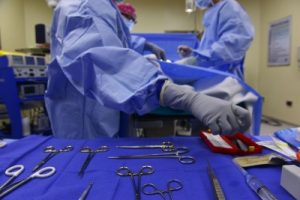
New Delhi, Feb 24 (IANS) In an intricate, one-of-a-kind case seen rarely in the world, a man in his 30s born with both male and female genitalia in his body was successfully operated on via minimally invasive robotic surgery, doctors at Amrita Hospital, Faridabad said on Friday.
Despite being married for five years, the man from Uttar Pradesh, was unable to have a child. After various tests, doctors at Amrita “found that his testes were still in his abdomen”.
He was suffering from Persistent Mullerian Duct Syndrome (PMDS) — a rare genetic disorder of sexual development that affects men that has less than 300 cases reported in medical history worldwide.
In such a condition, a person born as male develops both male and female reproductive parts. This happens because the gonadal structures that are forming during pregnancy undergo defective development.
The female structures like the uterus, fallopian tubes, and sometimes the ovaries, rather than disappearing as they normally would, develop in a male child and persist into adulthood.
“An MRI scan revealed that he also had female reproductive organs like the uterus and fallopian tubes inside his body. The patient was suffering from PMDS since his birth and was completely unaware of it,” said Dr. Manav Suryavanshi, Head of Uro-Oncology and Robotic Surgery at the hospital.
The doctors decided to perform keyhole surgery robotically as the risk of damage to normal male structures and ureters draining urine in the vicinity of female structures was high.
“The case was particularly complex as it involved combined male and female anatomy in a single person in the same area of the body with intermingled and fused anatomical structures,” Suryavanshi said.
In addition, “the intra-abdominal testes carry a four-fold higher than normal risk of developing malignancy. And the retained Mullerian remnants are known to cause recurrent urinary tract infection, stones, and voiding disturbances in which the muscles that control the flow of urine out of the body don’t relax completely, and the bladder never fully empties.
Via a robotic surgery approach, “all the abnormal structures like the uterus, fallopian tubes, round ligaments, and defective gonads like intra-abdominal testes were successfully removed in the patient,” Suryavanshi said.
Post the robotic keyhole surgery, the man had a faster recovery and was discharged two days after the surgery, Suryavanshi said, adding that he was counselled about the need for hormonal replacement therapy.
“I am very happy with the results of the surgery, and now I look forward to leading a normal life. This is a big burden off my chest,” the patient said.
–IANS
rvt/svn/
Related posts:
- 7 Important Points that are needed to be Considered about Implants
- Gujarat Open Golf: Udayan Mane, Viraj Madappa, Khalin Joshi, Yuvraj Sandhu lead title charge
- Cancerous skin lesion removed from Biden’s chest, no further treatment required: Physician
- OPD services to remain shut in Rajasthan on Wednesday










